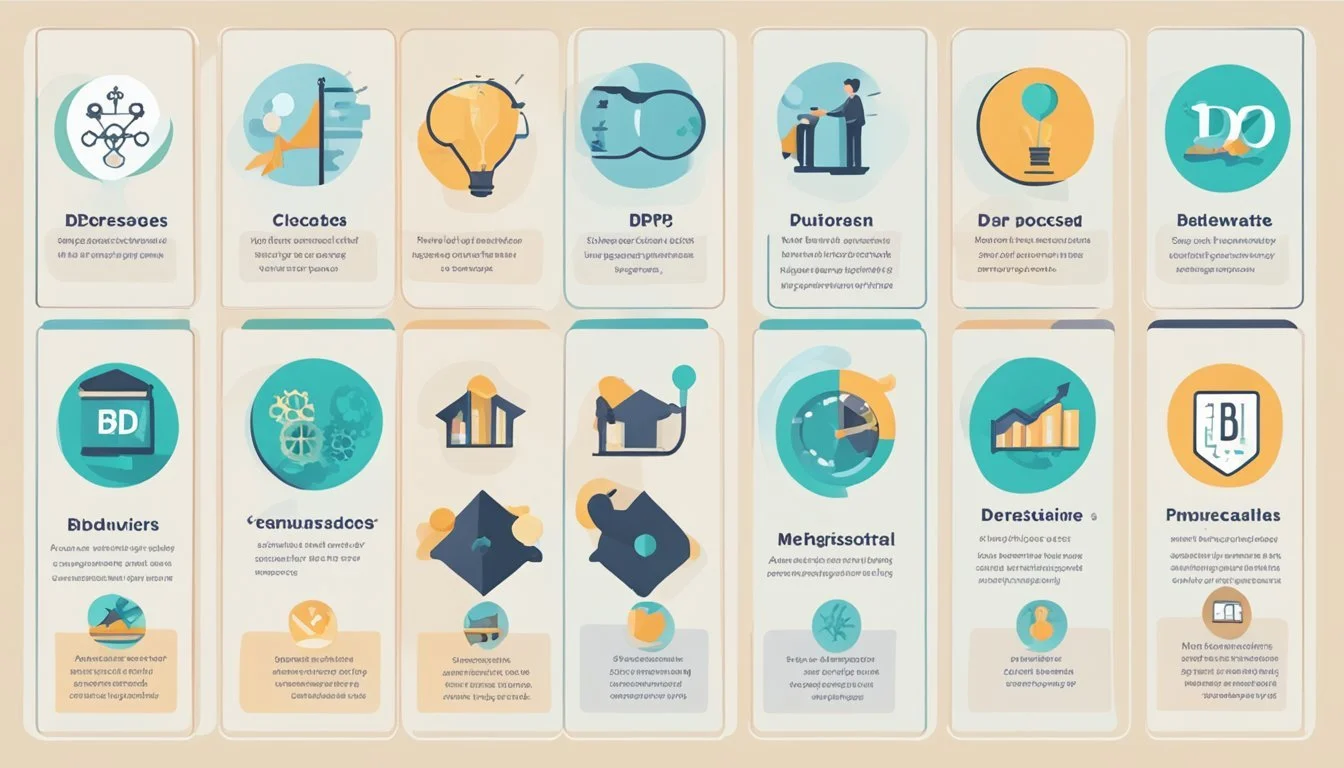10 Misconceptions About BPD Debunked
Setting the Record Straight on Borderline Personality Disorder
Borderline Personality Disorder (BPD) is a complex mental health condition that affects mood, behavior, and relationships. Despite increased awareness, misconceptions about BPD persist, often leading to stigma and misunderstanding.
Debunking common myths about BPD can help improve understanding and support for those affected by the disorder. This article aims to address ten prevalent misconceptions, providing accurate information to foster a more informed perspective on BPD and its impact on individuals' lives.
1) BPD is Untreatable
Contrary to popular belief, Borderline Personality Disorder (BPD) is not an untreatable condition. Many people with BPD experience significant improvement with proper treatment and support.
Effective therapies exist for managing BPD symptoms. Dialectical Behavior Therapy (DBT) has shown particularly promising results in helping individuals regulate emotions and improve interpersonal relationships.
Other evidence-based treatments include Cognitive Behavioral Therapy (CBT) and Mentalization-Based Therapy (MBT). These approaches can help people with BPD develop coping skills and gain a better understanding of themselves and others.
Medication may also play a role in treating specific symptoms associated with BPD, such as depression or anxiety. While there is no single medication for BPD itself, a combination of therapy and medication can be effective for many individuals.
With dedicated effort and professional help, many people with BPD experience a reduction in symptoms over time. Some even achieve remission, no longer meeting the diagnostic criteria for the disorder.
It's important to remember that treatment outcomes can vary, and recovery is often a gradual process. However, the notion that BPD is untreatable is a harmful misconception that can discourage people from seeking the help they need.
2) Only Women Have BPD
Borderline Personality Disorder (BPD) affects individuals of all genders, not just women. While statistics show that women are diagnosed with BPD more frequently, this does not mean men are immune to the condition.
Research indicates that approximately 75% of BPD diagnoses are given to women. However, this disparity may be due to various factors, including diagnostic biases and differences in how symptoms manifest across genders.
Men with BPD may express symptoms differently or be misdiagnosed with other conditions. Some healthcare professionals might overlook BPD in male patients due to preconceived notions about the disorder.
It's important to recognize that BPD can occur in people of any gender identity. The misconception that only women have BPD can lead to underdiagnosis and inadequate treatment for men and non-binary individuals who may be struggling with the disorder.
Raising awareness about BPD's prevalence across all genders is crucial for ensuring proper diagnosis and treatment for everyone affected by this challenging mental health condition.
3) BPD Equals Abusive Behavior
The misconception that individuals with Borderline Personality Disorder (BPD) are inherently abusive is both inaccurate and harmful. While some people with BPD may exhibit challenging behaviors, it is incorrect to assume that all individuals with this diagnosis engage in abusive actions.
BPD is characterized by intense emotions, fear of abandonment, and difficulty maintaining stable relationships. These symptoms can lead to impulsive actions or emotional outbursts, but they do not automatically translate to abuse.
Many individuals with BPD actively work on managing their symptoms through therapy and self-awareness. They often strive to build healthy relationships and improve their interpersonal skills.
It's important to recognize that abusive behavior is not a diagnostic criterion for BPD. People with this disorder can and do form loving, supportive relationships when they receive appropriate treatment and develop coping strategies.
Labeling all individuals with BPD as abusive perpetuates stigma and may discourage those who need help from seeking treatment. Each person with BPD is unique, and their behavior should be evaluated on an individual basis rather than through blanket generalizations.
4) BPD is Personality Flaws
Borderline Personality Disorder (BPD) is often mistaken for mere personality flaws or character defects. This misconception stems from a lack of understanding about the complex nature of the disorder.
BPD is a legitimate mental health condition recognized by psychiatric professionals. It involves a pervasive pattern of instability in interpersonal relationships, self-image, and emotions.
Individuals with BPD experience intense emotional reactions and struggle with impulse control. These symptoms are not simply personality quirks or flaws, but rather the result of neurobiological factors and environmental influences.
Research suggests that BPD has genetic components and is associated with structural and functional brain differences. Traumatic experiences, particularly during childhood, can also contribute to its development.
Viewing BPD as mere personality flaws dismisses the genuine struggles faced by those with the disorder. It can lead to stigmatization and prevent individuals from seeking proper treatment.
Effective therapies exist for BPD, including Dialectical Behavior Therapy (DBT) and other evidence-based approaches. With appropriate treatment, many individuals with BPD can manage their symptoms and lead fulfilling lives.
5) Medication Solves BPD
Contrary to popular belief, medication alone does not solve Borderline Personality Disorder (BPD). While certain medications can help manage specific symptoms, they are not a cure-all solution for this complex mental health condition.
Medications may be prescribed to address co-occurring issues like depression, anxiety, or mood swings. However, they do not directly treat the core features of BPD, such as unstable relationships, identity disturbances, or fear of abandonment.
The most effective treatment approach for BPD typically involves a combination of psychotherapy and, in some cases, medication. Dialectical Behavior Therapy (DBT) and other specialized forms of therapy have shown significant success in helping individuals with BPD develop coping skills and improve their quality of life.
It's important to note that medication decisions should be made in consultation with a mental health professional. Each person's experience with BPD is unique, and treatment plans need to be tailored to individual needs and circumstances.
While medications can play a supportive role in BPD treatment, they are not a standalone solution. Long-term management of BPD often requires ongoing therapy, skill-building, and lifestyle changes to achieve lasting improvement.
6) BPD and Bipolar Disorder are the Same
This misconception stems from some overlapping symptoms between Borderline Personality Disorder (BPD) and Bipolar Disorder. While both conditions involve mood changes, they are distinct mental health disorders with important differences.
BPD is a personality disorder characterized by unstable relationships, self-image, and emotions. Mood shifts in BPD are often rapid and triggered by interpersonal situations.
Bipolar Disorder, on the other hand, is a mood disorder featuring alternating episodes of mania and depression. These episodes typically last for weeks or months, unlike the quick mood changes in BPD.
The underlying causes of these disorders differ as well. BPD is thought to result from a combination of genetic and environmental factors, particularly childhood trauma or neglect.
Bipolar Disorder has a stronger genetic component and is linked to imbalances in brain chemistry. Treatment approaches for the two conditions also vary, with different medications and therapy techniques proving effective for each.
While misdiagnosis can occur due to symptom overlap, mental health professionals use specific criteria to differentiate between BPD and Bipolar Disorder. Accurate diagnosis is crucial for appropriate treatment and management of each condition.
7) People with BPD Enjoy Manipulating Others
This misconception stems from a misunderstanding of BPD behaviors. People with Borderline Personality Disorder do not inherently enjoy manipulating others or engage in manipulation for pleasure.
Their actions often result from intense emotions and a fear of abandonment rather than a desire to control others. BPD can cause difficulty in regulating emotions and maintaining stable relationships.
What may appear as manipulation is often an attempt to cope with overwhelming feelings or secure emotional support. These behaviors are not intentionally malicious but rather manifestations of the disorder's symptoms.
It's important to recognize that individuals with BPD are not a monolith. Like anyone else, they have diverse personalities and behaviors. Labeling all people with BPD as manipulative is inaccurate and harmful.
Treatment and therapy can help those with BPD develop healthier coping mechanisms and improve their interpersonal relationships. With proper support, individuals with BPD can learn to manage their symptoms effectively.
8) Trauma Always Causes BPD
Trauma is often associated with borderline personality disorder (BPD), but it is not the sole cause. While many individuals with BPD have experienced trauma, not all have a history of traumatic events.
Research indicates that 10-20% of people diagnosed with BPD report no significant childhood trauma. This suggests that other factors play a role in the development of the disorder.
Genetics, brain structure, and neurochemical imbalances can contribute to BPD. Environmental factors, such as unstable family dynamics or inconsistent parenting, may also influence its onset.
It's important to recognize that BPD can develop through a complex interplay of biological and environmental factors. Trauma may increase the risk, but it is not a prerequisite for the disorder.
Understanding this distinction helps reduce stigma and promotes a more comprehensive approach to diagnosis and treatment. It also acknowledges the diverse experiences of individuals with BPD.
9) People with BPD Can't Have Careers
Many individuals with Borderline Personality Disorder (BPD) successfully maintain fulfilling careers across various fields. While BPD can present challenges in the workplace, proper treatment and management strategies often allow those with the disorder to thrive professionally.
People with BPD possess diverse skills and talents that can be valuable assets in their chosen professions. Some find that their heightened emotional sensitivity enables them to excel in creative or empathetic roles.
Effective treatment, including therapy and medication when necessary, can help individuals with BPD develop coping mechanisms for managing symptoms at work. Many learn to regulate their emotions and maintain stable relationships with colleagues and supervisors.
Numerous examples exist of people with BPD achieving success in fields such as arts, sciences, business, and healthcare. With appropriate support and self-awareness, they can navigate workplace dynamics and contribute meaningfully to their organizations.
It's important to recognize that BPD affects individuals differently, and career experiences may vary. Some may require accommodations or find certain work environments more suitable than others.
10) BPD Makes Relationships Impossible
While Borderline Personality Disorder (BPD) can present challenges in relationships, it does not make them impossible. Many individuals with BPD maintain healthy, long-term connections with partners, friends, and family members.
Successful relationships often involve open communication, understanding, and mutual effort. People with BPD can develop skills to manage their symptoms and improve interpersonal interactions through therapy and support.
It's important to recognize that BPD symptoms can fluctuate, and not all relationships will be equally affected. Some individuals with BPD have stable careers, friendships, and romantic partnerships.
Support from loved ones can play a crucial role in managing BPD. When both parties are committed to understanding and working through challenges, relationships can thrive.
Treatment options like Dialectical Behavior Therapy (DBT) can provide individuals with BPD valuable tools for emotional regulation and interpersonal effectiveness. These skills can significantly enhance relationship quality.
While BPD may introduce unique dynamics, it does not preclude the possibility of meaningful, fulfilling relationships. With proper support and management, individuals with BPD can build and maintain strong connections.
Understanding Borderline Personality Disorder
Borderline Personality Disorder (BPD) is a complex mental health condition characterized by unstable moods, behaviors, and relationships. It affects how a person thinks and feels about themselves and others, often leading to impulsive actions and intense emotional reactions.
What Is BPD?
BPD is a psychiatric disorder that impacts a person's ability to regulate emotions and maintain stable relationships. It typically begins in early adulthood and can persist throughout life if left untreated. People with BPD often experience intense fear of abandonment, unstable self-image, and difficulty controlling anger.
The exact cause of BPD remains unknown, but research suggests a combination of genetic, environmental, and neurological factors contribute to its development. Childhood trauma, neglect, or abuse may increase the risk of developing BPD.
Symptoms And Diagnosis
BPD symptoms can vary in severity and frequency among individuals. Common signs include:
Intense mood swings
Unstable relationships
Impulsive behaviors
Chronic feelings of emptiness
Self-harm or suicidal thoughts
Diagnosis requires a comprehensive evaluation by a mental health professional. The Diagnostic and Statistical Manual of Mental Disorders (DSM-5) outlines specific criteria for BPD diagnosis. At least five of nine listed symptoms must be present for a diagnosis.
Treatment options for BPD include psychotherapy, particularly Dialectical Behavior Therapy (DBT), and in some cases, medication to manage specific symptoms. With proper treatment and support, many individuals with BPD can lead fulfilling lives and experience significant improvement in their symptoms.
The Impact Of Misconceptions
Misconceptions about Borderline Personality Disorder (BPD) can have serious consequences for those living with the condition. These false beliefs contribute to stigma and create obstacles to proper diagnosis and treatment.
Stigma And Social Isolation
People with BPD often face judgment and rejection due to widespread misunderstandings. Many are labeled as "attention-seeking" or "manipulative," leading to strained relationships. This stigma can cause individuals to withdraw from social interactions and hide their struggles.
Friends and family members may distance themselves, believing the myths that people with BPD are dangerous or impossible to deal with. As a result, those with BPD may experience intense loneliness and a lack of support when they need it most.
In professional settings, misconceptions can lead to discrimination. Employers may hesitate to hire or promote individuals with BPD based on unfounded fears about their behavior or reliability.
Barriers To Treatment
False beliefs about BPD create significant hurdles in accessing proper care. Some mental health professionals still hold outdated views, leading to misdiagnosis or inadequate treatment plans. Patients may be dismissed as "difficult" rather than receiving the specialized care they require.
The myth that BPD is untreatable discourages many from seeking help. This can result in worsening symptoms and increased risk of self-harm or suicide attempts. Even when individuals do seek treatment, they may encounter therapists who are reluctant to work with BPD patients due to misconceptions about the disorder.
Insurance companies sometimes limit coverage for BPD treatments, citing outdated beliefs about its treatability. This financial barrier prevents many from accessing evidence-based therapies like Dialectical Behavior Therapy (DBT).




